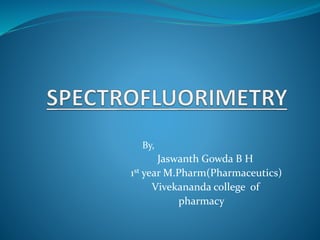
Spectrofluorimetry ppt
- 1. By, Jaswanth Gowda B H 1st year M.Pharm(Pharmaceutics) Vivekananda college of pharmacy
- 2. The term fluorescence comes from the mineral fluorspar(calcium fluoride) when Sir George G.Stokes observed in 1852 that fluorspar would give off visible light(fluorescence) when exposed to electromagnetic radiation in the ultraviolet wavelenth.
- 3. Introduction: (#)Many substances are able to absorb uv (or) visible Light energy but soon they lose energy as heat through collisions with neighbouring atoms. (#)Only few substances that lose part of energy as heat and emit the remaining energy as EMR of a wavelengh longer than that absorbed. (#)The following process of emitting radiation is called as luminescence.
- 4. Luminescence is of two types:- 1)Fluorescence 2)Phosphorescence FLUORESCENCE:- *When a beam of light is incident on certain substances, they emit visible radiations.This phenomenon is known as fluorescence and the substances shows this phenomenon are known as fluorescent substances. *This is instantaneous and starts immediately after the absorption of light and stops as soon as the incident light cut off. *They re-emit radiations generally within 10¯⁶ to 10¯⁴ second of absorption.
- 5. PHOSPHORESCENCE:- *When light radiation is incident on certain substances,they emit light continuously even after the incident light cut off and substances showing this phenomenon is known are known as phosphorescent substances. *They re-emit excess radiation within 10¯⁴ to 20 seconds or longer. *Thus,the life-time of phosphorescence is much longer than fluorescence.
- 6. THEORY OF FLUORESCENCE:- *In order to understand the theory of fluorescence, one should understnd the meaning of singlet and triplet state. *Ground singlet state:- electrons are paired. *Triplet state :- unpaired electrons of same spin. *Singlet excited state:- unpaired electrons but of opposite spin.
- 7. *When the molecules or atoms absorb uv or visible radiations of a proper frequency,one or more of the paired electrons get raised to an EXCITED SINGLET STATE from GROUND SINGLET STATE. *In this excited state,the spin of the electron doesn’t undergo any change and the net spin is still zero. *One more possibility is that one set of the electron spin may have undergone unpairing resulting in two unpaired electrons,which makes an excited triplet state. *small possibility of direct tansition from SGS to TES.
- 8. *When molecules are irradiated with light of appropriate frequency,it will be absorbed in about 10¯¹⁵ Seconds,then it moves from ground to first excited singlet state. *From excited singlet state,one of the following 3 phenomenon will probably occur,depending on the molecule. ( 1)excited molecule may return to ground state by collisional deactivation without emitting any radiation.
- 9. (2)excited molecule may emit uv or visible light photon,this is known as fluorescence. (3)excited molecule are quite stable so it will undergo transition from singlet excited state to triplet state and later return to ground state with emission of uv or visible light photon.this is known as phosphorescence. *process of crossing from singlet state to triplet state is termed as intercrossing system.
- 11. Factors affecting fluorescence:- Nature of molecules Nature of substituents Effect of concentration Adsorption Light Oxygen Photodecomposition Temparature and viscosity
- 12. Nature of molecules:- *Not all molecules can show the phenomenon of fluorescence ,only few which are able to absorb uv or visible can show. *Greater the absorbance of molecule,more the intense of its luminescence. *molecules containing conjugated double bonds(ex:-1,3 pentadiene etc..) are much suitable for this. *aliphatic and saturated cyclic compounds(ex:- butane,cycloalkanes etc..) are not sutable for this study.
- 13. Nature of substituents:- *Electron donating groups like –NH2, -OH often enhance fluorescence, but –SO3H, -NH4 and alkyl group donot have much effect on fluorescence *Electron withdrawing groups like –COOH, -NO2, -N=N- and halides decrease or even destroy fluorescence. *If high atomic number atom is introduced into a π electron system,it decreases fluorescence but enhances phosphorescence.
- 14. Effect of concentration:- *It’s already stated that fluorescence is proportional to concentration but it must be highlighted that the equation aplies only to small values *If greater the concentration then there won’t be linearity in calibration curve,leads to self quenching.
- 16. Adsorption:- *extreme sensitiveness of method requires very dilute solution,10-100 times weaker than those employed in spectrofluorimetry. *adsorption of fluorescent substance on container walls can cause major problems. *strong stock solutions are diluted. ex:- quinine.
- 17. Light:- *Monochromatic light is required for excitation. Oxygen:- *it oxidises the fluorescent to non fluorecent substances. *due to paramagnetic property of molecular energy,it decreases fluorescence.
- 18. Temperature and Viscosity:- *increase in temparature leads to collissional deactivation thus results in decreased fluorescence. *increased viscosity leads to decreased collisional deactivation which in turn results increased fluorescence. pH of solution:- *alteration in ph of solution show significant effect on fluorescence. Phenols:- acidicundissiciate formNo fluorecence. alkalinedissociated formgood fluorescence.
- 19. Reference:- 1.Instrumental Methods of Chemical Analysis by G.R. Chatwal 2.Instrumental Methods of Chemical Analysis by B.K. Sharma
- 20. THANK YOU
